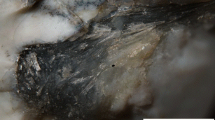Abstract
IIb trioctahedral chlorite in the Barberton greenstone belt (BGB) metavolcanic rocks was formed during pervasive greenschist metamorphism. The chem‐ical composition of the chlorite is highly variable, with the Fe/(Fe+Mg) ratio ranging from 0.12 to 0.8 among 53 samples. The chemical variation of the chlorite results from the chemical diversity of the host rock, especially the MgO content of the rock, but major details of the variation pattern of the chlorite are due to the crystal structure of the chlorite. All major cation abundances in the chlorite are strongly correlated with each other. Sil‐icon increases with Mg and decreases with Fe, while AlIV and AlVI decrease with Mg and increase with Fe2+. A complex exchange vector explains over 90% of the chlorite compositional variation: Mg4SiFe2+ −3AlVI −1 AlIV −1, which has 3 parts Fe-Mg substitution coupled with one part tschermakite substitution. This ratio is required to maintain the charge and site balances and the dimensional fit between the tetrahedral and octahedral sheets. The subtle change in Al substitution in chlorite implies that AlVI is preferentially ordered in the M(4) site, and about 84% of the AlVI present is in the M(4) sites when they are nearly filled with AlVI. Based on 47 analyzed chlorite-bearing rock samples, chlorite (Chl) composition is strongly correlated with the MgO content of the host rock. Calculated correlation coefficients are +0.91 for SiO2Chl-MgORock, −0.87 for Al2O3Chl-MgORock, +0.89 for MgOChl-MgORock, and −0.85 for FeOChl-MgORock. Only weak correlations have been found between chlorite oxides and other oxides of rock (between same oxides in chlorite and rock: SiO2−0.67, Al2O3 + 0.59, FeO −0.41). However, MgOChl is saturated at about 36 wt% in rocks that have MgO above 22 wt%.The MgOChl is about 5 wt% when the host rock approaches 0 wt% of MgO. This implies that Mg substituting into the chlorite is approximately limited to 1.5–9.2 Mg atoms per formula unit and 1.0–3.2 AlIV. Chlorite geothermometers can not be applied to all BGB samples. However, the empirical chlorite geothermometer based on AlIV of chlorite may be applicable to chlorites formed under metamorphic conditions because it can predict the chemical composition of the chlorite from basaltic and dacitic samples in this study. An estimated temperature of about 320°C for the greenschist metamorphism of the greenstone belt through this geothermometer is consistent with that obtained by other geothermometers.
Similar content being viewed by others
Author information
Authors and Affiliations
Additional information
Received: 22 January 1996 / Accepted: 15 August 1996
Rights and permissions
About this article
Cite this article
Xie, X., Byerly, G. & Ferrell Jr., R. IIb trioctahedral chlorite from the Barberton greenstone belt: crystal structure and rock composition constraints with implications to geothermometry. Contrib Mineral Petrol 126, 275–291 (1997). https://doi.org/10.1007/s004100050250
Issue Date:
DOI: https://doi.org/10.1007/s004100050250




